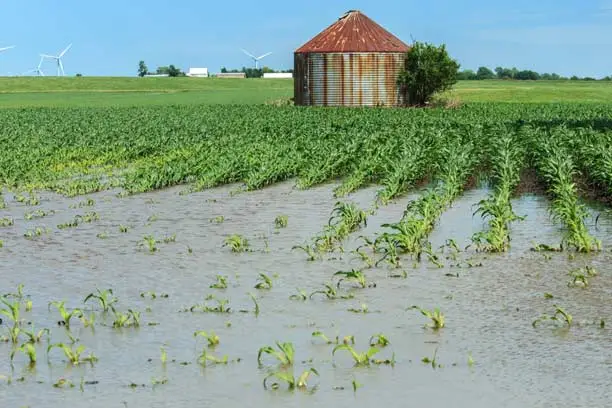7 Steps to Protect Your Crops From Flooding


There’s always a risk of crop damage from flooding or saturated soil. Don't let a flood wash away your harvest — the right preparations, including floodplain management strategies and farm drainage solutions — can help you reduce loss and maintain your yields.
According to the University of Wisconsin–Madison, ideal soil is generally 45% minerals, 5% organic matter and 50% pore space. That pore space should be filled evenly by air and water.
When water fills that space and drives out the air, plants can’t get enough oxygen and nutrients. Some plants can die within a day, especially in warm temperatures. Others can live for up to a week. Those that live might have lower yields due to root damage.
Following these seven steps before flood season begins can help you minimize flood damage.
Some crops are designed to perform better in flooded conditions, especially if they are mature in their growth process. Tall corn that has a strong, established base may withstand extreme conditions if you’re in an area at risk for flooding.
Adding and maintaining drainage systems can help remove excess water from your fields. You may want to use:
Be sure these systems are clear and in good working condition before planting season starts so you’re ahead of the curve.
Minimizing tillage can help your soil hold more water, along with other benefits, according to Iowa State University. Tilling can disrupt and damage soil. So, soil that’s tilled less can withstand flooding better.
Cover crops help water infiltrate soil better, so flooded soil dries out more quickly, according to Farm Progress.
Organics in your soil can help it hold more water, so it’s less likely to become saturated. Consult with your local agronomist to determine what organic matter will be most beneficial to your specific soil and field, and how much to use.
If flooding is predicted, check your fields to make sure all drainage ditches are open and clear debris that could damage your crops or machinery, according to the Center for Food Security and Public Health.
Even with all these steps in place, your farm could still suffer losses due to flooding. Sometimes weather events are too severe, or storms keep coming back-to-back so the soil doesn’t get enough time to drain. That’s why you need crop yield insurance.
Crop yield insurance covers damage from flooding, hail, droughts and other natural disasters. Buying crop insurance before you plant can help you protect your farm’s revenue.
There are a range of federal programs that help protect crops. Your local Farm Bureau agent can help you review the options available and choose those that are right for your operation.
Farm Bureau is the nation’s number one ag insurer1, so we know how to help you manage risk on your farm. We can review your operation and help you find the best insurance coverage for your crops, livestock, property, vehicles, business and more. Reach out to Farm Bureau today to learn how we can help.